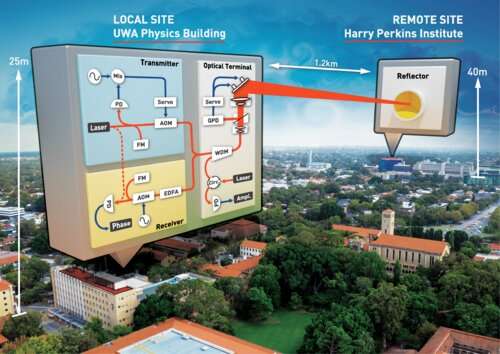January 24, 2022 report
A new record for laser stability across atmospheric distances

A team of researchers at the University of Western Australia has set a record for stability when sending a laser beam across an atmospheric distance. The group describes their laser system in the journal Physical Review Letters.
Scientists have been eager to increase the distance of laser signaling. Currently, the technology is limited by natural world factors such as wind and minor vibrations affecting equipment. In this new effort, the researchers established a stable laser over a distance of 2.4 kilometers, making it 100 times more stable than prior laser systems. The researchers note that their laser was also more stable than atomic clocks.
The team used a host of features to keep the beam stable, including temperature controls, noise reduction and automatic adjustments to the devices holding the equipment. The test involved sending a beam from a building's fifth-floor window to a site 1.2 kilometers away. The distant target consisted of a mirror to bounce the laser beam back to a device near the source of the laser. The beam was held in place for approximately five minutes.
Once a long-distance means of sending laser signals is established, scientists expect them to be used to communicate between ground stations and satellites or orbiting craft. They also would like to use them to connect atomic clocks. Connecting one clock on the surface of the Earth to one aboard a spacecraft would allow for testing Einstein's general theory of relativity—the clock in space should run slightly faster than the one on the ground.
Stable lasers could also be used to improve the technology involved in launching vehicles into space. And they could also be used to create a very large atomic clock network for testing a variety of physics theories, including those surrounding the nature of dark matter. Such lasers would have to be impervious to constantly changing wind speeds, temperatures, cloud turbulence and ground movements, and they will have to be able to do it over distances much farther than has been achieved thus far.
More information: D. R. Gozzard et al, Ultrastable Free-Space Laser Links for a Global Network of Optical Atomic Clocks, Physical Review Letters (2022). DOI: 10.1103/PhysRevLett.128.020801
Journal information: Physical Review Letters
© 2022 Science X Network





















